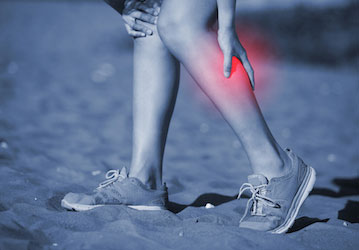Delayed onset muscle soreness (DOMS) is a minor muscle injury that has symptoms of muscle stiffness, pain, tenderness, and sometimes swelling. Though DOMS symptoms are similar to a muscle strain (also known as a pulled muscle), there are some key differences between the two.
First is what actually happens to your muscle. A muscle strain is caused by an overstretch of the muscle fibers where severity is graded on a scale from 1–3. A grade 1 strain is an overstretch causing mild muscle-fiber separation, grade 2 is usually a partial tear of the muscle, and grade 3 typically is a complete tear of the muscle. So when you hear somebody say, “It’s just a strain,” it can actually mean a range of things from fairly mild to a severe injury. Compared to a strain, DOMS is relatively minor. While the jury’s still out on what exactly causes DOMS, it’s thought to be due to muscle damage on the microscopic level.
Next is the timing of your pain. Strains typically happen during exercise. For instance, if you’re sprinting and suddenly feel a sharp pain in the back of your leg, you likely have a hamstring strain that will take several weeks to stop hurting and fully heal. On the other hand, DOMS starts well after the exercise that caused it, usually 48–72 hours later, and it can last about a week.
On top of general muscle soreness, DOMS can cause noticeable weakness when you move the muscle group that’s affected. Most people notice reduced pain within 5–7 days, but see your medical provider if the pain lasts longer than a week or gets worse. Persistent or worsening pain could be due to rhabdomyolysis, which is a rare, but life-threatening condition that includes severe muscle pain with swelling similar to cramping, but without the muscle actually tightening. The other key symptom of rhabdomyolysis is dark, tea- or cola-colored urine. If you notice any of these symptoms, go to an emergency room right away.
Can I prevent and/or treat DOMS?
There’s limited research on surefire ways to prevent and manage DOMS. However, active-recovery strategies can help relieve your pain and soreness.
- Recovery drinks. Carbohydrates and protein might help prevent DOMS. Protein-based drinks such as chocolate milk can help reduce muscle soreness and fatigue after exercise.
- Amino acid supplements. Consuming essential amino acids or branched-chain amino acids during endurance exercise has been shown to help reduce post-exercise soreness as well. Visit Operation Supplement Safety to learn more about the safe and effective use of dietary supplements.
- Medicines. Over-the-counter, non-steroidal anti-inflammatory medications (NSAIDS) such as ibuprofen or naproxen can also help reduce inflammation caused by muscle damage, which might also reduce pain. Taking anti-inflammatories can speed up recovery too, but limit their use to less than one week. Pain that lasts longer than one week is generally not DOMS, so it’s crucial to see your medical provider.
